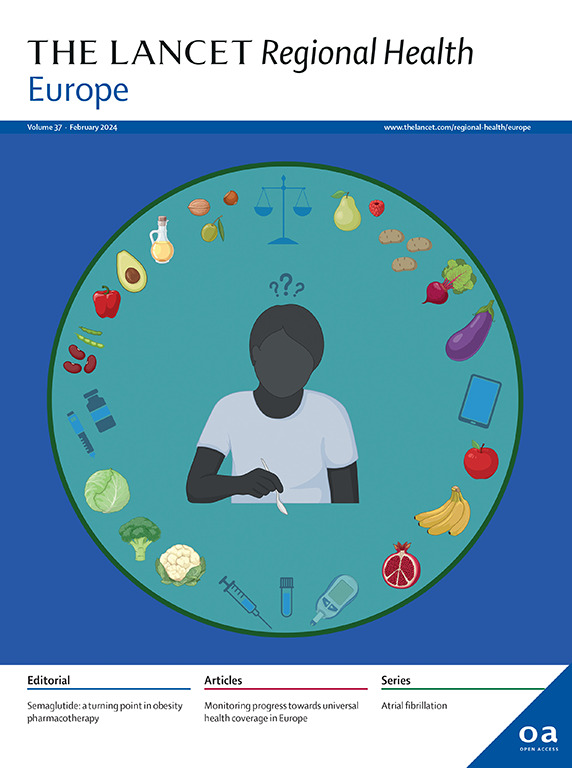Adolescent mental health before, during, and after the COVID-19 pandemic in Iceland: a repeated, cross-sectional, population-based study
IF 13.6
Q1 HEALTH CARE SCIENCES & SERVICES
引用次数: 0
Abstract
Background
Adolescents' mental health declined during the COVID-19 pandemic, yet little is known about the long-term outcomes after the pandemic's declassification as a global health emergency (5 May 2023). This study examined changes in adolescent mental health in Iceland from 2016 to 2023, using a bioecological framework to identify risk and protective factors.
Methods
Youth in Iceland surveys were administered nationwide to 13-15-year-olds in 2016, 2018, 2020, 2021, 2022 and 2023, with an average 75% response rate across the years. The surveys included measures on depressive symptoms, anxiety and hostility (Symptom Checklist-90), parental social support (Perceived Parental Support Scale), screen time, and stress/trauma exposure (Negative Life Events Scale). Stepwise-reduced mixed-effects models assessed the association of age, gender, time and risk/protective factors and their effect on mental health. Multiple imputation addressed missing data, and Bonferroni corrections adjusted for multiple testing.
Findings
62,011 adolescents participated: 48.2% female (n = 29,890), 50.0% male (n = 31,002), 1.8% non-binary (n = 1119). Depressive symptoms showed signs of improvement post-pandemic (2023) compared to 2021 (β 0.19, 95% CI 0.13–0.24), yet remained higher than pre-pandemic levels (2016: β −0.38, 95% CI −0.44 to −0.33; 2018: β −0.26, 95% CI −0.31 to −0.20). Anxiety and hostility also increased and remained higher than pre-pandemic levels in 2023 (anxiety: 2016 β −0.29, 95% CI −0.35 to −0.24, 2018 β −0.20, 95% CI −0.26 to −0.15; hostility: 2016 β −0.26, 95% CI −0.31 to −0.20, 2018 β −0.12, 95% CI −0.18 to −0.07). Across all the models examining the predictors from diverse bioecological spheres, low parental social support, high social media use, and bad grades were consistently associated with poor mental health, regardless of mental health outcome and gender.
Interpretation
The COVID-19 pandemic has had a serious and continuing negative effect on adolescents’ mental health. Targeted interventions are needed to address the increase in mental health problems during the COVID-19 pandemic, with a focus on enhancing parental support and managing screen use.
Funding
Icelandic Research Fund (217612-051); NordForsk (147386).
冰岛COVID-19大流行之前、期间和之后的青少年心理健康:一项重复的、横断面的、基于人群的研究
背景:在2019冠状病毒病大流行期间,青少年的心理健康状况有所下降,但人们对此次大流行被解密为全球突发卫生事件(2023年5月5日)后的长期后果知之甚少。这项研究调查了2016年至2023年冰岛青少年心理健康的变化,使用生物生态学框架来确定风险和保护因素。方法冰岛青年调查于2016年、2018年、2020年、2021年、2022年和2023年在全国范围内对13-15岁的青少年进行了调查,历年平均回复率为75%。调查包括抑郁症状、焦虑和敌意(症状清单-90)、父母社会支持(感知父母支持量表)、屏幕时间和压力/创伤暴露(消极生活事件量表)。逐步减少的混合效应模型评估了年龄、性别、时间和风险/保护因素之间的关系及其对心理健康的影响。多重输入解决了缺失数据,Bonferroni修正调整了多重测试。结果62,011名青少年参与其中:48.2%女性(n = 29,890), 50.0%男性(n = 31,002), 1.8%非二元(n = 1119)。与2021年相比,大流行后(2023年)抑郁症状有改善迹象(β 0.19, 95% CI 0.13-0.24),但仍高于大流行前水平(2016年:β - 0.38, 95% CI - 0.44 - 0.33;2018年:β - 0.26, 95% CI - 0.31至- 0.20)。焦虑和敌意也有所增加,并在2023年保持高于大流行前的水平(焦虑:2016 β - 0.29, 95% CI - 0.35至- 0.24,2018 β - 0.20, 95% CI - 0.26至- 0.15;敌意:2016β−0.26,95% CI 0.31−−0.20,2018β−0.12,95% CI 0.18−−0.07)。在检查来自不同生物生态领域的预测因子的所有模型中,无论心理健康结果和性别如何,低父母社会支持、高社交媒体使用和成绩差始终与心理健康状况不佳相关。2019冠状病毒病大流行对青少年心理健康产生了严重和持续的负面影响。需要采取有针对性的干预措施,以解决COVID-19大流行期间精神卫生问题的增加,重点是加强父母的支持和管理屏幕使用。冰岛研究基金(217612-051);NordForsk(147386)。
本文章由计算机程序翻译,如有差异,请以英文原文为准。
求助全文
约1分钟内获得全文
求助全文
来源期刊

Lancet Regional Health-Europe
Multiple-
CiteScore
19.90
自引率
1.40%
发文量
260
审稿时长
9 weeks
期刊介绍:
The Lancet Regional Health – Europe, a gold open access journal, is part of The Lancet's global effort to promote healthcare quality and accessibility worldwide. It focuses on advancing clinical practice and health policy in the European region to enhance health outcomes. The journal publishes high-quality original research advocating changes in clinical practice and health policy. It also includes reviews, commentaries, and opinion pieces on regional health topics, such as infection and disease prevention, healthy aging, and reducing health disparities.
 求助内容:
求助内容: 应助结果提醒方式:
应助结果提醒方式:


